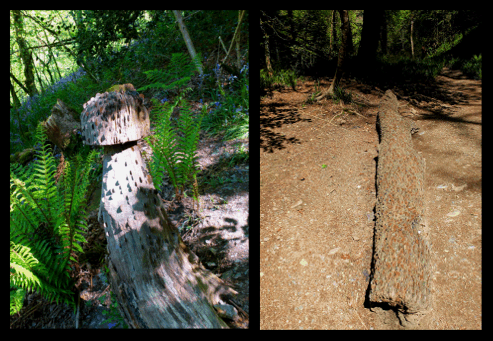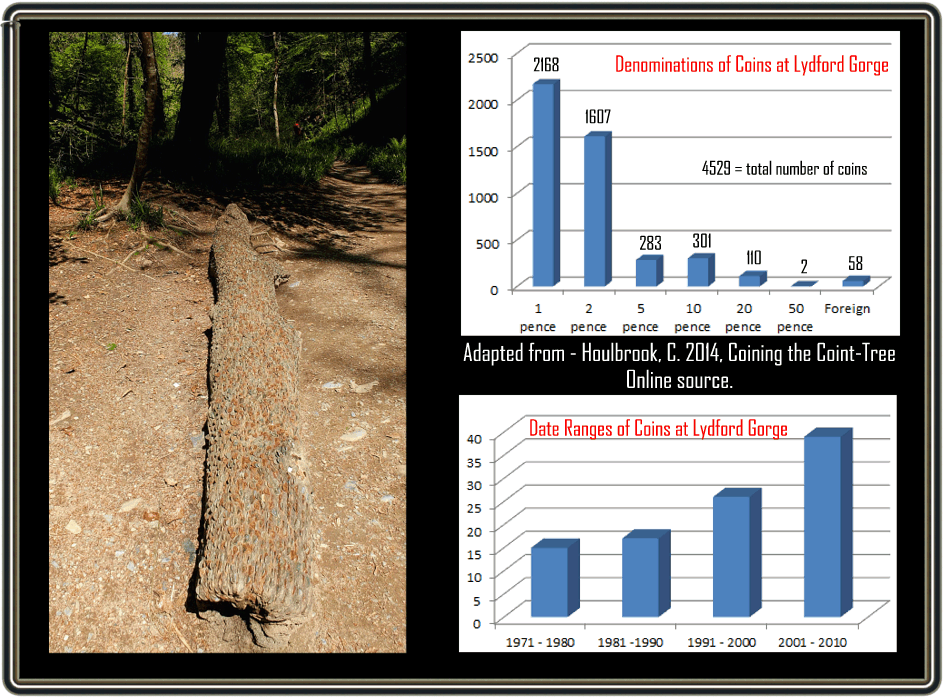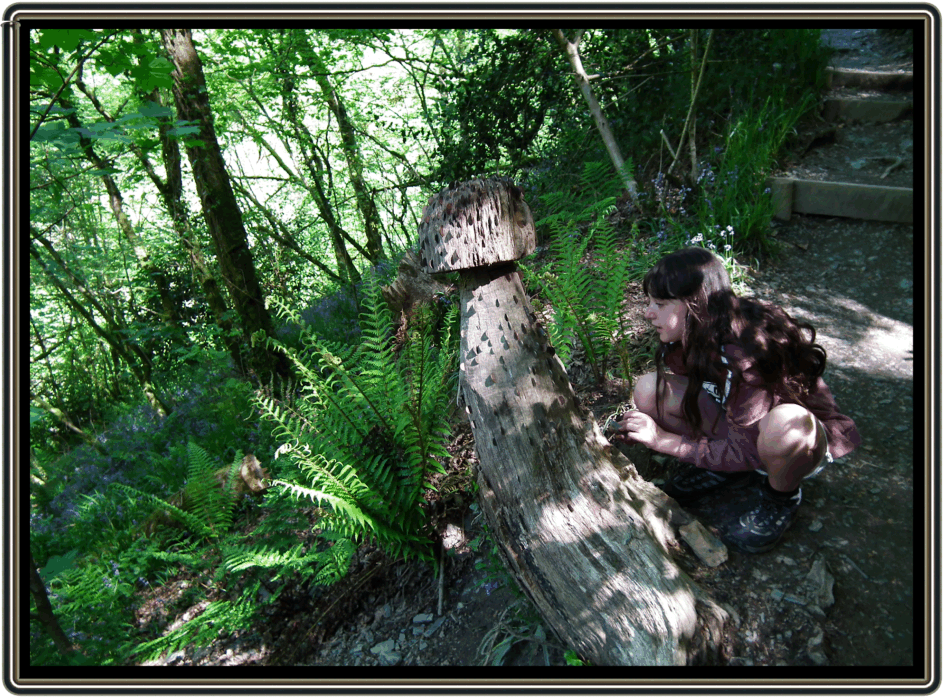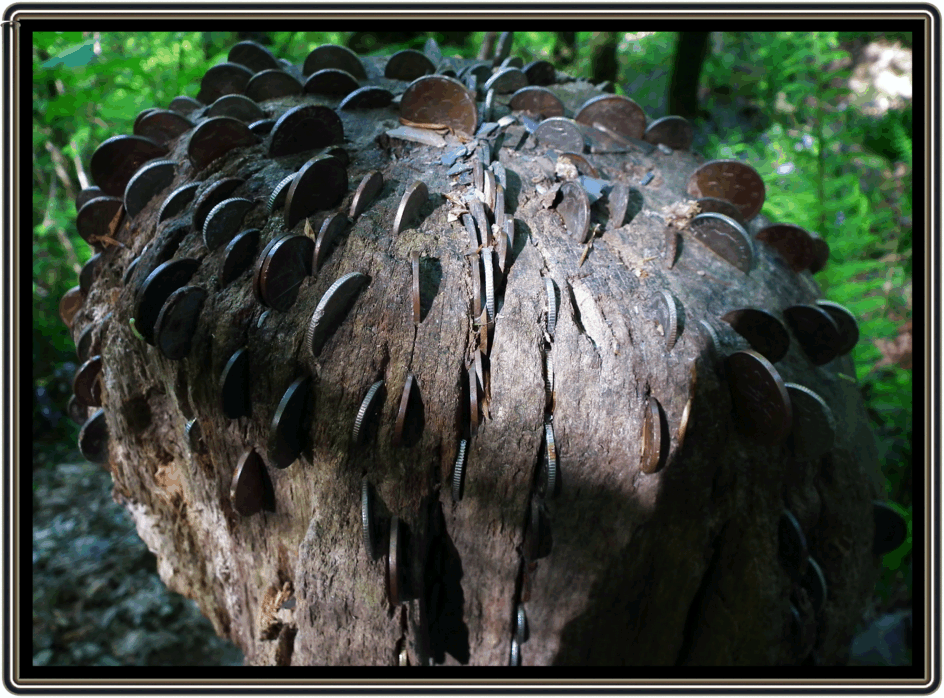
It is said that; “money does not grow on trees,” which in essence is completely true but there are instances where from appearance it looks as if money does grow on trees. There are also examples where money seems to be growing from timbers used in old buildings. To be more exact in most cases the ‘money’ comes in the form of coins, usually low denomination ones such as pennies of varying ages. This is not a phenomenon exclusive to Dartmoor, although there are some splendid examples to be found, but is a world-wide tradition. But what is the purpose of these ‘money or wishing trees’ and what exactly are they?
As can be seen from the examples below they are normally old tree stumps or logs which have been literally studded with coins and to be found in several woodland locations. However in some old buildings timber beams have been subjected to the same treatment. On several instances I have nearly been scalped by such low-level beams in old buildings as being over six feet tall the coins protrude at head height. But why would people want to embed coins into various forms of wood? one could similarly ask why do people toss coins into wishing wells etc? If you ever come across a ‘money tree’ and inspect the hoard of coins embedded in it you will see that most of them are modern coins, probably from around the 1970s onwards. This would suggest that the tradition of ‘donating’ money in such a way is a modern one, however, it is thought in some quarters that this custom dates back to the 1700s although the first reference comes from 1863 in regard to a coin tree on the Isle of Maree. In 2013 a team of archaeologists made a small, non-evasive excavation of the site on which the Scottish ‘Armaddy Wishing Tree’ was located. Around the tree they discovered 691 coins which had clearly fallen from the bark, their dates ranged from 1914 to 2011. It was thought at the time that had they dug down deeper they possibly would have found more coins.
Since pagan times trees and wood have always regarded as holding some degree of mysticism as it was thought they held an association with various gods. Vestiges of this belief have trickled down to modern times for example why do we say;”touch wood,” or “knock on wood,” before a hopeful statement. One explanation is that in the eyes of early pagans (and some modern ones) it was thought that evil spirits lurked in wood. Therefore when speaking about a future hope touching or knocking would prevent the spirits from hearing your desires thus stopping them from dashing your hopes. But on the other hand there was/is the notion that some wood deities had the capability of granting wishes and desires. In the case of ‘money trees’ the widespread belief that depositing ‘money’ acts as a votive offering in order to get a wish granted. Usually that ‘wish’ would be in the form of a cure for a personal illness or one afflicting a loved one. In order for this act to be effective the ‘coin’ had to be driven deep into the wood ensuring it penetrated the bark. But there could be another reason behind embedding a coin deep into the wood. In order to do this the chances are that in the process the coin would become bent or twisted in some way. In folklore there has been a deep-rooted belief that ‘bowed’, ‘crooked’ or ‘bent’ coins were considered to be good luck charms. There was an early ritual where a penny would be bent over the sick bed of a patient and along with prayers in the hope that a full recovery would be made. In the sixteenth century bent coins were carried for protection against bad luck. It was said they once a year pennies would be ritually bent to afford protection to the hawks belonging to King Edward 1st. Some bent coins found hammered into ‘money trees’ testify to the fact that the depositor has well and truly observed this tradition albeit without any knowledge of the ‘bending’ origins. Sometimes ‘money trees’ are associated with the Piskies as they acted as a type of ‘piskie bank’. It was here they stored the coins they had taken off travellers in payment for being made invisible and therefore assured of a safe journey.
For centuries metal objects have been embedded in trees with the belief that the metal would act as a conduit for carrying the disease or illness from the person into the wood. I think it would be fair to say that few people would have gone especially equipped with a metal object and would have used something that normally would be carried. In early times it would have been unlikely that a coin would have been used as they were far too valuable, hence objects such as pins or nails were used. Today the most common objects carried by most folk are coins and so when encountering a ‘coin tree’ the chances are that a low denomination coin would be used. Look at a ‘coin tree’ and you will immediately notice that the majority of the coins are either one or two pence coins with the occasional five or twenty pence piece. Today this may well imply a few things; firstly that low value coins are today regarded as ‘disposable’ due to their low value and worth and very few people would lament the loss of such coins. Secondly, if someone was seriously desperate enough for a wish to be granted surely the votive offering would be a one or two pound coin? Does this indicate that low value coins are deposited because people believe they should leave something because other people have and its a quaint thing to do?
Another notion as to why folk deposit coins in money trees could simply be as a token of their visit, a sort of ‘kilroy waz here‘ gesture. Very much in the tradition of leaving a stone on a cairn its a personal act which in a way leaves a tiny part of those who leave them. There also is the possibility that people encountering a ‘coin tree’ may well be accompanied by children and it is these youngster who ask; “can we put a coin in the log Daddy?” So in order to placate their children the parents will rummage for the lowest value coin as a token gesture and to get some peace and quiet.

There can be no question that the number of people visiting ‘coin trees’ and leaving a coin has dramatically increased over recent years, but why should this be so? Since the 1990s there has been a huge rise in the popularity of spending leisure time in the outdoors and has led to an increase in the number of visitors to cultural and heritage sites. Some visitors will be on holiday and taking advantage of the local attractions whilst other folk will be day trippers exploring their nearby places of interest. For whatever reason this increase in visitors numbers has led to the growing popularity of ‘coin trees’. Additionally this rise in people visiting ‘coin trees’ may partly be the influence of the internet, with such sites as Google Search and the many photographic sites such as Flickr more people become aware of them. This then may spark some interest and lead to a visit and a coin deposit. It could also be argued that once a ‘coin tree’ becomes established it then also becomes a work of art. For this reason folk want to see it and in some ways be allowed to ‘engage’ with it in what normally is a aesthetic setting. The experience may simply be to photograph the tree, actually touch it, smell it or leave a token of their visit, something they could not easily do with a piece of art in a gallery. An interesting exercise would be to ‘seed’ a log or stump at one of the popular tourist attractions with a single coin and then see how fast it accumulates its ‘wealth’.
There are several famous examples of popular money trees on Dartmoor, twelve can be found dotted around Lydford Gorge. In 2013 a study was made of the Lydford Gorge ‘money trees’ whose origins are thought date to around 1997. It was found that the twelve ‘trees’ were either made up of either logs, stumps or wooden posts. Below is some data from that study and as you can see much of it reflects many of the trends noted above. By far the low denomination coins are the most popular coins to deposit with not a one above the value of fifty pence. The date ranges of the coins show a steady increase over the period of thirty nine years which could suggest both a growing number of visitors to Lydford Gorge and an increase in those actually leaving offerings in the ‘coin trees’. However, just because a penny dated 1999 was found it may have been in the depositors possession for a while and was actually left in 2009 so some caution needs applying to this data.
At Becky Falls there is another ‘coin tree’ called the ‘Pixie Money Tree’ which has become a favourite attraction. There is a ‘legend’ attached to this particular one which states that in order not to be devoured by ‘The Serpent’ a coin should be placed on the tree. This would act as a ‘toll’ for the pixies who would then ensure safe passage to the person depositing the coin. Clearly this has been introduced by the owners of the falls to add some mystique to the tree and make it a feature of the walk, especially for the youngsters on the trail.
A much smaller ‘coin tree’ can be seen along the footpath between Rushford and the Mill End hotel. For a good example of a timber studded beam there is none better (or dangerous) that one in the ceiling of room one in the Castle Inn at Lydford. For the huge amount of currency in both coin and note form The Highwayman Inn at Sourton has to be the richest place for ‘votive offerings’. They literally festoon the place with money lurking in the beams, walls and the host of curiosities that are dotted in every nook and cranny. Should anyone know of any other Dartmoor ‘money trees’ I would much appreciate them letting me know via this website.
There are two other forms of ‘money tree’ which both symbolise the association of good fortune. Here is a newspaper report coming from 1914 “Great excitement prevailed on Friday evening last when the old saying; “when the money tree bears fruit,” was really to be put into practice. A big crowd began to assemble, when the money tree, in the shape of Mr. A. E. Howard appeared at the residence of a fellow townsman and threw out handfuls of money amongst the crowd to be scrambled for. There was a great rush, people were hustled about, and toes stepped upon without much ceremony.” Quite often the ‘money tree’ would be either a form of generosity, as above, or a way of raising charitable funds. At a fund raising event small ‘money tree’ would be placed and people would be invited to attach monetary donations to it. At the high point of the proceedings the money would be taken off the tree and the gifts would be counted and then donated to the chosen charitable cause.
The second type of money tree is a real tree – Pachira aquatica otherwise known under a variety of names; the Malabar Chestnut, the French peanut, the Guiana chestnut, the provision tree, the saba nut and the pumpo. It is native to Central and South America and is often sold as a houseplant. In Eastern Asia the ornamental version of the ‘money tree’ is symbolically associated with good financial fortune. It is said that the reason the plant got its name was due to a poor man who was in the forest praying for money when he noticed a strange looking plant growing nearby. He thought this to be an omen that his prayer would be answered and so took it home with him. Before long his friends and neighbours saw the plant and asked if he could sell them one which over time he did and as the plant’s popularity grew so did his sales and fortune.
 Legendary Dartmoor The many aspects past and present of Dartmoor
Legendary Dartmoor The many aspects past and present of Dartmoor



